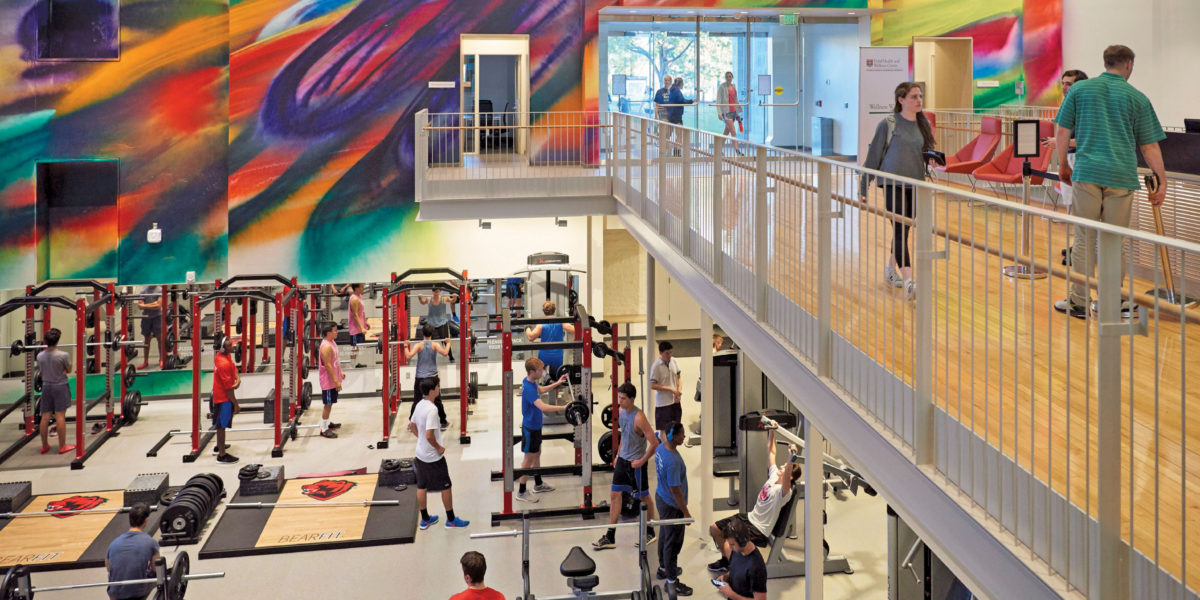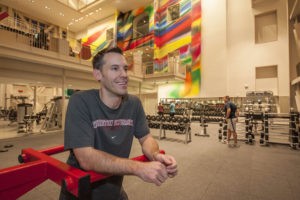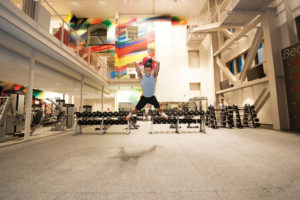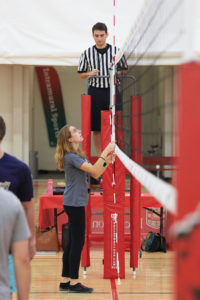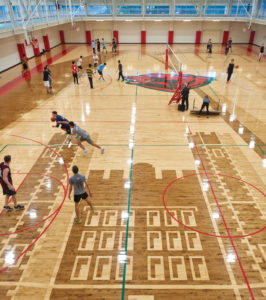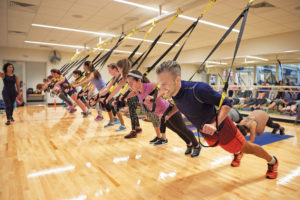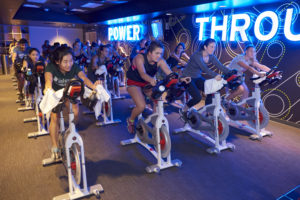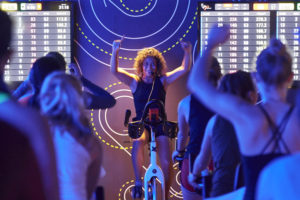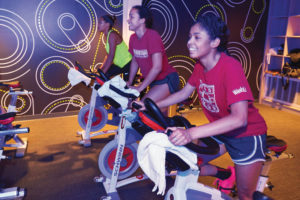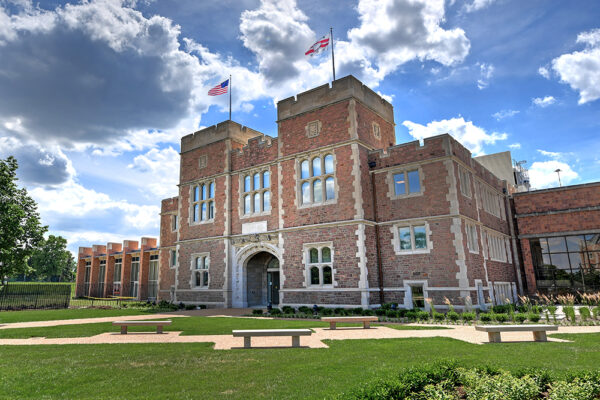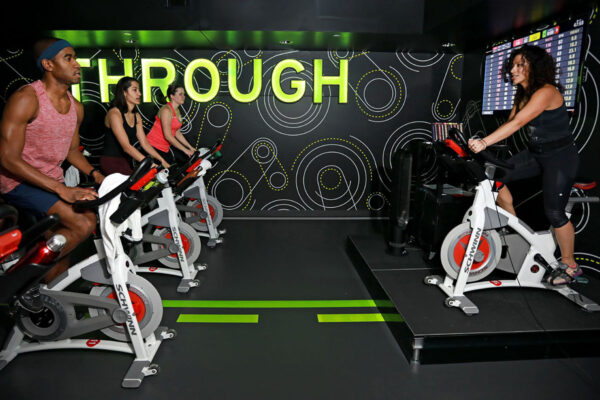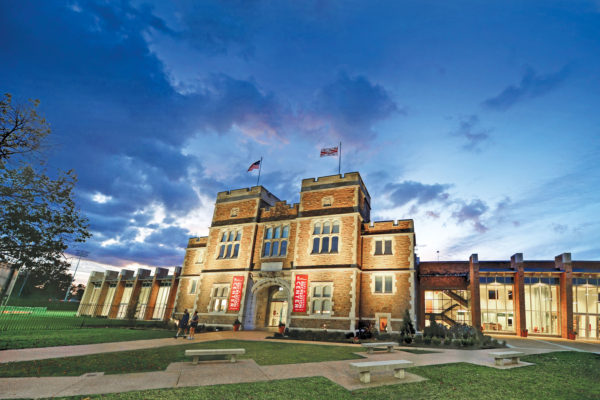The Gary M. Sumers Recreation Center debuted Oct. 29, 2016, and was embraced immediately as a place for all of Washington University — students, staff, faculty and alumni. To learn more about the facility and its popularity, Diane Keaggy, senior news director of campus life, spent a full day at Sumers, arriving before dawn and leaving long past sunset. During her Nov. 3 visit, she discovered a place where the university community comes together to play, exercise, de-stress and connect with one another.
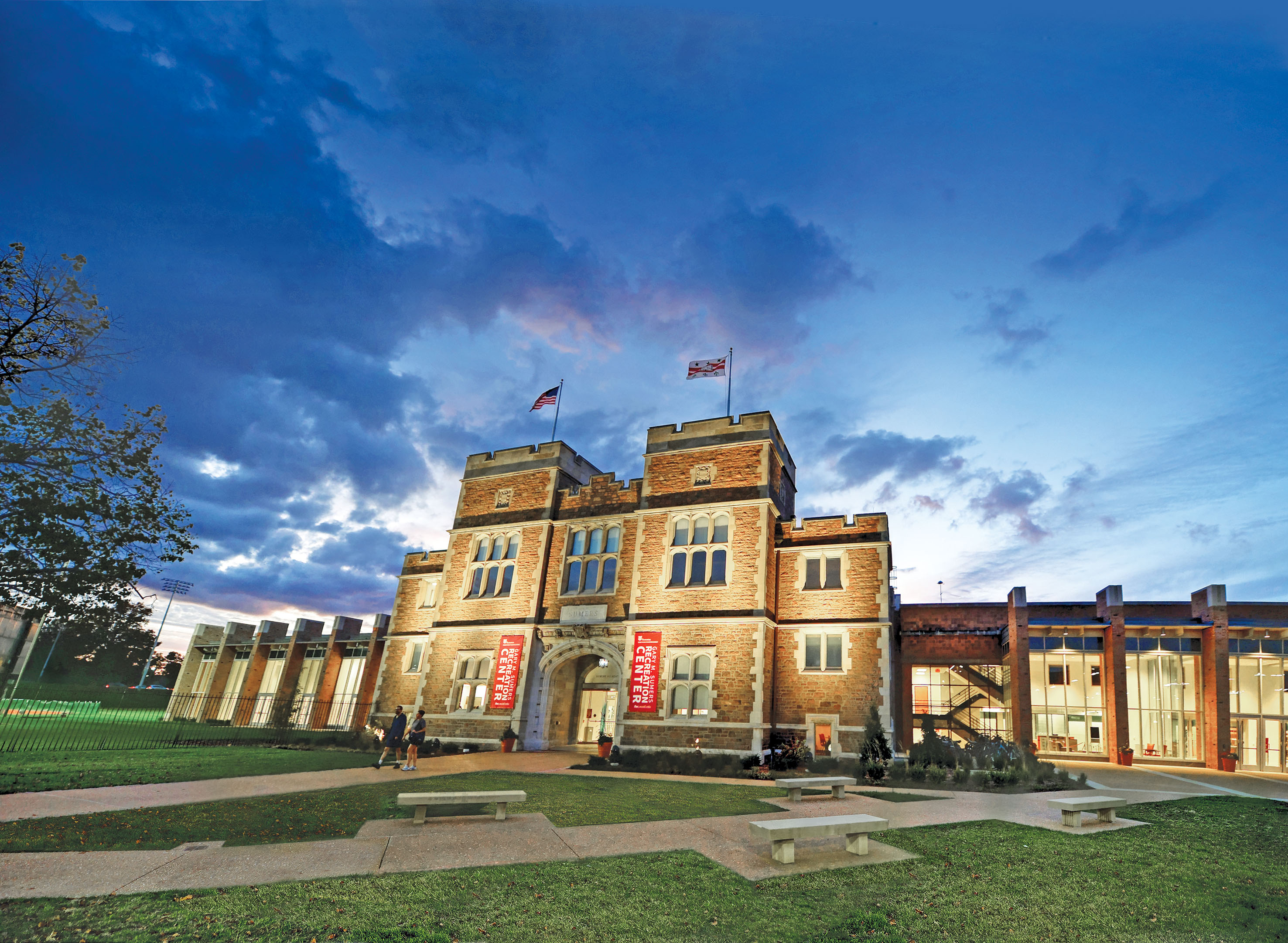
6:30 a.m. — The Throw Wall
Bryan Lenz likes to get in a workout before heading into the office. So today, he rose before dawn for some weights and cardio at the new Gary M. Sumers Recreation Center. Then it’s off to his desk, just up the stairs and down the hall from the gymnasium.
“When you work at your gym, there are no excuses,” says Lenz with a laugh.
Lenz is Washington University’s first director of recreational sports and campus fitness. That makes him both a manager and a member of the Sumers Recreation Center. He helped select the center’s equipment, hire new instructors and build a class schedule.
“The goal was to create a place where everyone — regardless of age, interests or fitness level — would feel welcome.”
— Bryan Lenz
“The goal was to create a place where everyone — regardless of age, interests or fitness level — would feel welcome,” Lenz says. “We did that. Personally, I feel very motivated here, and I’m so happy others do too.”
The $55 million Sumers Recreation Center is named for Washington University alumnus and trustee Gary M. Sumers, AB ’75, who committed $12 million to the project (see pg. 53 for more on Gary M. Sumers). Designed by acclaimed architecture firm Bohlin Cywinski Jackson in association with St. Louis firm Hastings+Chivetta Architects, the center comprises a transformed Francis Gymnasium, home to the 1904 Olympics, and a 66,500-square-foot addition. Features include 72 cardio machines, a spinning room, two fitness studios, a three-court gym with a suspended running track, and a “Zen Den” staffed by licensed massage therapists and outfitted with massage chairs.
But before its debut as a rec center, Sumers enjoyed a brief moment in the national spotlight. On Oct. 9, 2016, the Athletic Complex hosted the second presidential debate, making it the fifth debate hosted by the university since 1992. The Donald Trump campaign occupied the spinning room, and the Hillary Clinton campaign worked from a yoga studio. Some 2,000 journalists filed their reports from the gymnasium.
“What a way to break in this space!” Lenz says. “But I’m glad it’s ours now.”
Seth Alms, a technical support specialist who works on the West Campus, agrees.
“I couldn’t wait for this place to open,” says Alms, who is also here for a morning workout. “It’s got everything. More space? Check. Better equipment? Check. Longer hours? Check. And the people are family.”
Lenz marvels as Alms hurls a medicine ball nine feet in the air, drops for a burpee and springs to his feet in time to catch the ball. Alms then moves into a handstand and crosses the floor.
“Man, you should be on American Ninja Warrior,” Lenz says. “You could represent WashU.”
Alms laughs.
“I’m just happy to be here,” Alms replies. “I was stuck in traffic for 20 minutes, but now I’m having fun. Life is good, and this place helps it.”
Noon — The Olympic Studio
During the early planning stages of Sumers, engineering librarian Lauren Todd made one request: lunchtime classes.
“Like so many of us on staff, my time is limited,” Todd says. “I need to make it count.”
So Todd was thrilled when Sumers announced daily classes that fit her schedule. On this day, Todd is in the Olympic Studio doing walking lunges, squat jacks and planks during a 30-minute lunchtime boot camp with instructor Haleigh Spencer, a strength and conditioning specialist. Half of the class is staff; the other half is students. And, by the end, everyone is winded.
“See you next time,” Todd says to an undergraduate.
She knows some colleagues are wary of working out with students, but Todd likes it.
“I’m working out for me,” Todd says. “These classes are a big stress reliever, and they keep me accountable. If undergraduates want to make fun of my form, that’s on them. But that has not been my experience. This space is for everyone.”
3 p.m. — The Lobby
It’s easy to spot Jamie Kolker, university architect and associate vice chancellor; he’s the only one here in a tie. On this day, he’s meeting with architects to discuss locker room improvements.
“The response to Sumers has been overwhelming and not just from students,” Kolker says. “Staff, faculty and other members of the community are exploring all the facility has to offer.”
Sumers is the result of years of planning. University leaders studied recreation centers at peer institutions, surveyed students and employees, solicited donations and collaborated with architects and interior designers. The new center is a bright, functional space that meets today’s needs but also celebrates university history.
“Imagine: Olympic athletes from 1904 entered through these very doors,” Kolker says.
Sumers represents the first major update to university fitness facilities since the renovation of the Athletic Complex in 1984. Back then, in the era of leg warmers and aerobics, only 13 million Americans belonged to a health club. Today, the number is 55 million.
“People exercised then, but the focus we see today on health and wellness and nutrition had yet to take root on a broader scale,” Kolker says. “We fell behind quickly. Sumers definitely brings us back up to speed.”
5:30 p.m. — The Zen Den
Sumers has been open less than a week and already Christal Zhu is a regular of the Zen Den.
Every day after work, Zhu slips into one of the Zen Den massage chairs for a 20-minute session. An accountant on North Campus, Zhu sits in front of a computer all day.
“My shoulders get so tight,” says Zhu, stepping into the darkly lit room. As the chair expands to hug her frame, she adjusts the heat setting and exhales deeply. Zhu emerges refreshed and ready for her 6 p.m. energy sculpt class.
“I feel like a queen,” she says.
6 p.m. — The Three-Court Gym
Senior Sarah Taylor is setting up the volleyball net for the first intramural volleyball game of the season. Reigning champion SAE will face off against ZBT. The stakes couldn’t be lower.
“No one really cares who wins, but it’s fun,” says junior Brian Liebowitz, a member of SAE.
Still, Taylor wants to make sure the rules are followed, and the game is fair. As intramural sports supervisor, she will oversee the line judges and referees who will officiate the evening’s eight scheduled games.
“A lot of people think it would be awful to ref their friends, but I love it,” says Taylor, who is studying urban studies and Spanish in Arts & Sciences. “I’ve discovered I kind of like being the boss.”
Intramural sports (IM) have always been popular on campus — too popular given the Athletic Complex’s limited space. But the dedicated three-court gym means a bigger and better IM program, says Jamaica Cannon, assistant director of intramural sports. Some 270 teams are currently signed up for 30 intramural sports, a number that she expects to grow in 2017–18. During the 2016–17 season, the rec gym will host about 550 IM games, and they all need refs. Thankfully, she has Taylor.
“To be a great ref, you need more than knowledge of the rules. You need great leadership skills,” Cannon says. “You have to manage conflict and be confident in your decisions. Sarah has all those qualities and more.”
7 p.m. — The Dark Room
Cycling instructor Meghann Feely, assistant director of fitness and wellness, jumps on her bike and asks who is new to spinning. Freshman Lelandra Randle, along with a third of the class of 25, raises her hand.
“Fantastic,” Feely shouts. “Get ready to move.”
Feely’s class is modeled after SoulCycle, the wildly popular fitness craze that combines spinning and club music. Indeed, the studio, with its top-notch sound system and dark lights, feels like a nightclub — only this nightclub has wall-mounted monitors that display how fast and how hard every cyclist is pushing.
“Way to go, No. 24,” Feely shouts to the class leader.
“So it’s exciting to work with young people and to teach them how to take care of themselves now and for the rest of their lives.”
— Meghann Feely
Feely — part coach, part emcee — keeps the party bouncing through 60 minutes of drills. Before joining Washington University, Feely worked at private gyms, often with women who were dismayed by how weak and exhausted they had become in middle age.
“Fitness and wellness had never been part of their history,” Feely explains before the class. “So it’s exciting to work with young people and to teach them how to take care of themselves now and for the rest of their lives.”
At the end of the session, Randle dismounts her bike and mops the sweat from her forehead. She’s been missing this.
“I’ve been so focused on school that I just haven’t been able to work out the way I’d like to,” says Randle, a pre-med student. “I’m so exhausted, but it’s a good exhausted. And I can’t wait to come back.”
Diane Toroian Keaggy, AB ’90, is senior news director of campus life.
